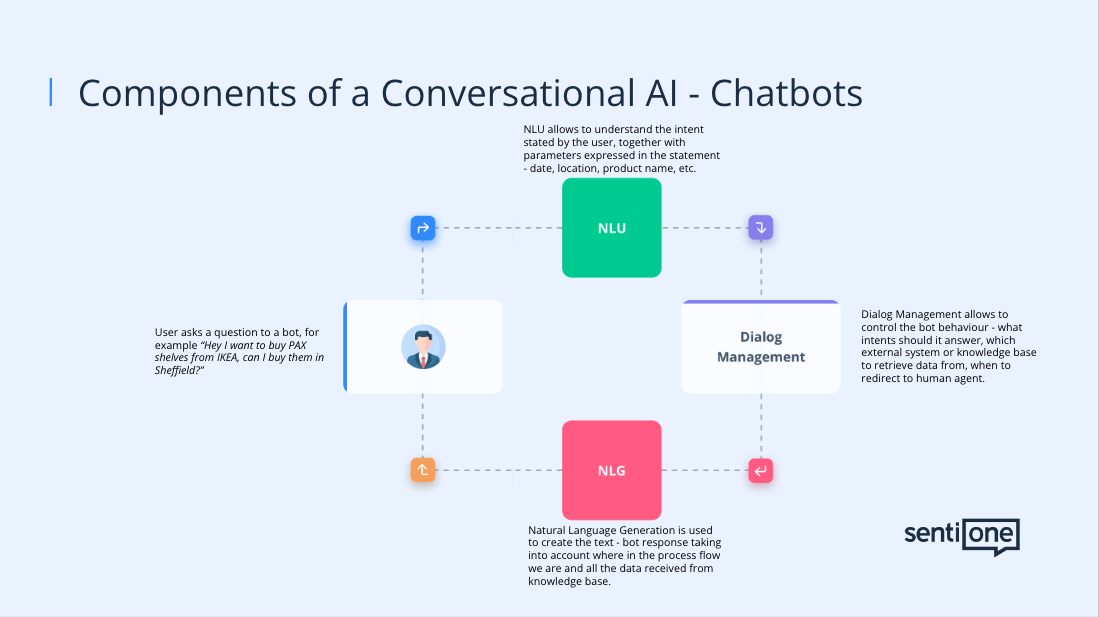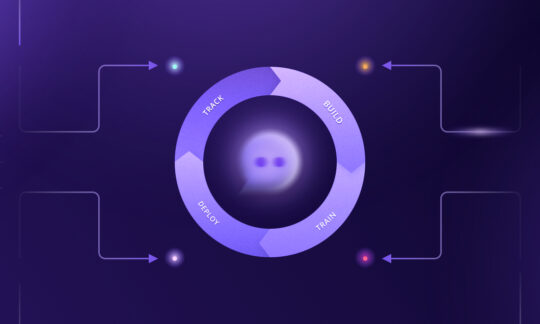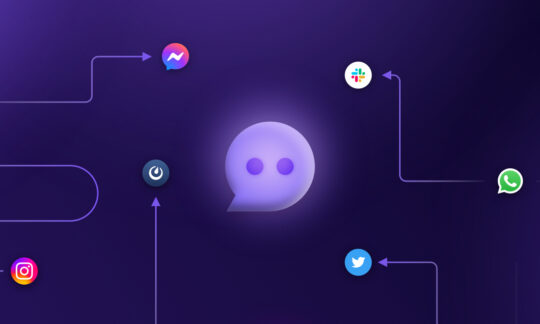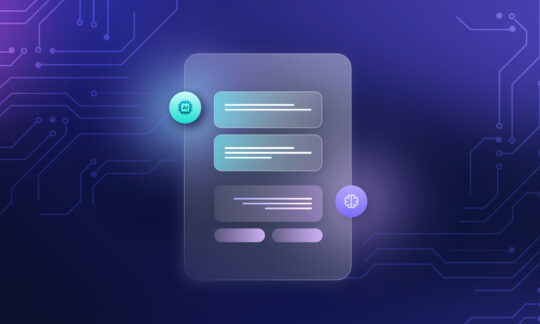What Is an AI Chatbot? Everything You Need to Know
Table of contents
- What Is a Chatbot?
- Rule-based vs Conversational AI Chatbots
- How Do Chatbots Work?
- Why Do Businesses Need Chatbots?
- Challenges of Building Chatbots
- How Chatbots Evolve with Generative AI
- The Future of AI Chatbots
- Choose the Right Conversational AI Platform for You
- Useful Definitions
- Article Summary
Everywhere you look, there is an article or social post about conversational and generative AI. And to no surprise. After all, according to Gartner, “by 2027, chatbots will become the primary customer service channel for roughly a quarter of organisations.” As a result, bot designers and builders will play a crucial role in facilitating customer-to-brand communication. This makes the ability to create chatbots one of the most desired skills in this day and age.
We wanted to go beyond the hype and give you a practical guide to AI bot building that you can use in your everyday work. Starting today. With this article we’re kicking off the Bot Building Series – in each new post will be walking you through all the important steps of bot development, from chatbot design and conversation flow, through NLU training to integrations and implementation.
This series is for you – made by bot designers for bot designers.
Let’s start from the basics. In this article you’ll learn about:
- Bot design and bot building.
- Types of chatbots and their use cases.
- Generative AI in chatbot building.
- The future of Artificial Intelligence chatbots.
What Is a Chatbot?
A chatbot is a program that understands and responds to user inputs, offering information and assistance or completing tasks using predetermined rules or AI algorithms. They are used in various applications as customer service chatbots, customer support chatbots, and messaging platform bots.
We distinguish between two aspects of creating a chatbot.
The creative aspect is the chatbot design, which includes:
- Determining the target audience and matching the bot’s tone of voice accordingly.
- Writing responses, composing the conversation flows, and ensuring a good user experience.
- Designing the look and feel of the interface.
On the other hand, the technical aspect of bot creation is bot building. This part involves:
- Programming of the designers’ flows – bringing your bot to life.
- Ensuring that bots understand users’ inputs correctly, process information effectively, and provide appropriate responses.
- Establishing connections between external sources, like databases and APIs, and the chatbot.
Simply put, bot designers ensure that a chatbot functions according to its intended use case, supporting customer service agents and helping clients reach their goals.
Rule-based vs Conversational AI Chatbots
We can divide chatbots into two categories: rule-based and conversational AI chatbots.
Rule-based Chatbots
Rule-based chatbots lack artificial brains. When engaging with such a chatbot, it will follow a specific, determined path only. It follows human-made rules or a decision tree to the letter.
Rule-based chatbots are effective in close-ended questions, like surveys, product feedback, or talk rating at a conference. In addition, they are cheaper and easier to implement than conversational AI chatbots.
They apply Natural Language Processing (NLP) to understand the users’ text input. However, being limited by the rule engine, rule-based chatbots can get lost in the ambiguity of human language. Moreover, implementing them as virtual assistants can lead to frustrations when users repeatedly hit the wall in the conversation flow.
Conversational AI Chatbots
Conversational AI chatbots utilise artificial intelligence, Machine Learning (ML) and Natural Language Processing (NLP), which allows them to mimic human conversation.
AI chatbots get smarter with each conversation, providing more accurate, personalised responses. Also, they are much more sophisticated in retrieving the right information from external sources provided by bot designers.
How Do Chatbots Work?
We provide a step-by-step guide on how to build your bot in the next instalment of this series. But, for now, let’s have a look at the basic operations of a chatbot.
First, you should be familiar with the difference between key natural language processes.
- Natural Language Processing (NLP) is an umbrella term for machines interacting with human language.
- Natural Language Understanding (NLU) is a subset of NLP that involves a higher-level language understanding, extracting context and intent behind inputs.
In short, an interaction with a conversational AI bot is a four-step multi-turn loop consisting of:
- User inputting information or asking questions in the chatbot.
- NLU analysing the input, finding intent, and additional information, like data, location, or products.
- Dialog Management pairing the intent with the right part of the conversation flow and accessing external systems or knowledge bases to find appropriate data.
- Natural Language Generation creating a response based on information obtained in Dialog Management and sending it back to the user.

Components of a conversational AI chatbot
Why Do Businesses Need Chatbots?
Chatbots have been around since the 1960s. The technology has been continuously improved over decades, penetrating new markets and finding new audiences. According to an Uberall study, 80% of people who have interacted with a chatbot say the experience was generally positive.
Most bot’s business use cases fall into information-oriented and task-oriented chatbots.
Information-oriented Chatbots
As the name suggests, information-oriented chatbots are designed to provide users with answers to their queries. These chatbots are adept at retrieving accurate and relevant FAQ responses from databases, websites, or APIs.
For example, you can use information-oriented chatbots as:
- Interactive interfaces that help navigate comprehensive user-facing knowledge bases.
- Virtual tour guides that inform visitors about exhibits, provide historical facts, and answer their questions.
- Health information providers that answer health-related questions, provide guidance on symptoms, suggest first aid procedures, and recommend home remedies.
Task-oriented Chatbots
Task-oriented chatbots are more proactive. They can perform specific tasks or actions, making them more transactional. They have a particular purpose of guiding users through predefined workflows or processes. They are designed to understand and respond to specific commands or intents related to their assigned task.
To do that, they engage in a multi-turn conversation with users, using the Dialog Management mentioned in the previous section. In addition, this step-by-step guidance can involve accessing connected APIs to perform needed actions, like verifying users before disclosing personal information or adding new data to the system.
Task-oriented chatbots are great at:
- Appointment scheduling. With their help, users can easily check for availability, schedule appointments, receive reminders, and manage any necessary rescheduling or cancellations.
- Financial services. A conversational AI chatbot can provide users with account information, perform transactions, and answer financial questions (especially useful in banking and insurance institutions).
- Order tracking. Buyers can check real-time status updates and estimated delivery times and ask about order details.
Challenges of Building Chatbots
Chatbots are only as good as the dataset they are built on. If the data is in any way biased, corrupted, or false, your chatbot will mislead users or discriminate against them, which can only lead to frustration and an increased churn rate.
To improve the comprehension abilities of your chatbot, make sure you use datasets that include a range of sentence structures, synonyms, and real-world examples that capture the nuances of language. This is why generative AI is so helpful in speeding up the bot-building process (more on that below). Lucky for you, SentiOne Automate (our conversational AI platform) has pre-trained NLU models and generative AI integration.
Of course, you might encounter errors even with great, clean datasets. As a bot designer, you need to continuously check and identify areas where chatbots make mistakes, and detect common errors, further increasing the accuracy of intent recognition.
On the other hand, the most challenging aspect of bot design is getting lost in the complexities of conversation flows. Having a low-code visual flow builder at your disposal can make the process more intuitive.
Finally, there is also an issue of convincing clients to trust and use chatbots. It’s hard to blame their reservations considering that until not so long ago the only type of chatbot that was available to companies to implement was a robotic-sounding bot with a very low intent detection accuracy. Today, with state-of-the-art conversational AI chatbots at your fingertips, giving your users a lifeless shell would be a waste of opportunity (and business). Especially since the “ability to hold a more ‘human’-sounding, natural conversation” was one of the most frequently indicated areas of improvement in the abovementioned Uberall report. This is why at SentiOne we believe in creating chatbots that people want to talk to.
How Chatbots Evolve with Generative AI
The next step in the evolution of chatbots is the addition of generative AI based on Large Language Models (LLMs). The most prominent example here is ChatGPT. The popular tool has access to all information available on the Internet up until September 2021. With all that data, it can generate responses to users’ questions, not unlike chatbots.
Here’s the crux of the matter: at SentiOne, we believe that while generative AI technology-based tools are excellent for process automation and speeding up the NLU model training, they are not ideal for business use cases.
First, impressive as it might be, using the entire Internet as your knowledge base isn’t necessarily a good thing. You probably saw first-hand ChatGPT giving you an answer that is neither true nor contextually appropriate. As a business, if you were to integrate it into your chatbot, you’d have no control over the answers, data storage, or security.
In contrast, AI bots created with Automate are trained on specific and curated datasets. These datasets can be self-contained, ensuring the security of private information — especially important in the healthcare and financial industries. Automate can also be easily integrated with CRMs for, e.g., authorisation processes.
That being said, as mentioned earlier, ChatGPT is an excellent tool for speeding up the bot design process.
Here are just a few examples of what generative AI can create:
- Similar phrases. ChatGPT can instantly provide you with ten alternate versions of a sentence like: “Tell me how to access my bank account number.” These examples are used to train the NLU model.
- Synonyms which ensure the model understands different ways a user can be talking about, for example, credit cards.
- Conversation flows. You can ask ChatGPT to create a flow that starts with a user asking, “Where is your closest branch?”.
- Bot responses. ChatGPT is great for quick ideation on non-information-specific answers, like different ways of saying: “Here is the information you were looking for.” Since ChatGPT can be creative to some extent, it can help you to define the tone of voice that matches your brand.
In our research, we’ve found that using generative AI in training NLU models can speed up the bot-building process by 60%.
The Future of AI Chatbots
Back in 2021, Salesforce stated that chatbot adoption was rising despite challenges. That adoption will most likely accelerate thanks to low-code/no-code platforms paired with generative AI tools, like ChatGPT. Next year, the industry is predicted to be worth $142 billion, according to Juniper Research. And the market is expected to grow by 23% in the next five years.
An increasing adoption of generative AI and AI-assisted tools is not the only trend we see when it comes to chatbots.
To us, conversational AI bots are also heading towards becoming team agnostic. As a result, companies will no longer create multiple chatbots for marketing, sales, and customer service. Instead, they will aim towards one virtual assistant functioning as the extension of their brand.
Choose the Right Conversational AI Platform for You
Today, you’ve learnt what a chatbot is, its types, how they work, and why it’s not a walk in the park to design them. But don’t worry. With SentiOne Automate, you’ll take your first steps with confidence.
You don’t need to be a skilled developer. Our intuitive bot builder has a no-code interface, drag-and-drop features, and reusable components. In addition, SentiOne Automate lets you test your bot conversations before launch, and you can analyse your chatbots in real-time.
And while you wait for the next part of this series, download our comprehensive chatbot guide for more information.
Useful Definitions
Here are some useful definitions of concepts discussed in this article:
-
- Bot design — the creative part of chatbot creation that includes composing conversation flows and writing bot responses.
- Bot building — the technical part of chatbot creation that includes programming the flows and connecting bots to APIs and databases.
- Natural Language Processing (NLP) — a subset of Artificial Intelligence that combines linguistics, computer science, and analysis, enabling machines to interpret speech and text and provide contextually appropriate replies.
- Natural Language Understanding (NLU) — a subset of NLP that focuses on extracting context and meaning from natural language inputs. Essentially, it refers to the process through which a computer comprehends the input provided by a user.
- Conversational AI — a technology that enables machines to understand, interpret, and respond to human input in a conversational manner by applying Machine Learning and NLP algorithms.
- Generative AI — a subset of artificial intelligence that focuses on creating and generating new content.
- Chatbot — a software solution that lets people receive answers to their questions through a conversation-like interface.
- Voice bot — a software solution that lets people receive answers to their questions through spoken commands.
- Large Language Model — an advanced artificial intelligence technology designed to effectively comprehend and analyse human language, trained on large quantities of unlabelled text.
Please note that when discussing chatbots, we also mean voice bots. The primary distinction between them is the mode of communication, but they share the same underlying technology, with the addition of voice-specific technologies. Consequently, both solutions have similar use cases. Therefore, the principles discussed in the Bot Building Series can be applied to both chatbots and voice bots without any significant differences.
Article Summary
The article introduces the Bot Building Series, which provides a practical guide to designing and building chatbots. It explains the basics of chatbot design and building, differentiates between rule-based and conversational AI chatbots, and discusses the importance of generative AI in chatbot development. The article also highlights the use cases of information-oriented and task-oriented chatbots and outlines the challenges in building chatbots, such as dataset quality and conversation flow complexity.



